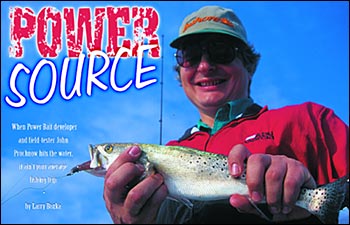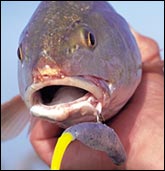
When Power Bait developer and field-tester
John Prochnow hits the water,
it ain't your average fishing trip
By Larry Bozka
An angry and ominous thunderhead is building fast on the far eastern
quadrant of Aransas Bay, and the water is reacting accordingly.
Clear turns to dingy green; slick goes to sloppy and, within a
few minutes, churning whitecaps with dirty, beer-foam heads are
dancing everywhere on the wind-raked surface.
Redfish Lodge's Capt. Brian Holden looks apprehensively at the
swelling, black-laced clouds and threatening skies and apologizes - as
if he could do something about it - to John Prochnow. Prochnow casually
makes another cast from the bow and peers back over his shoulder
at Holden.
"No problem, Brian. This is great!"
Weird thing is, he's serious.
John Prochnow is anything but your average, run-of-the-mill angler.
A brilliant young chemist who Outdoor Technologies Group (now
"Pure Fishing") lured away from Marianna Research Labs
back in 1986, 40-year-old Prochnow is one of the most influential - if
not the most influential - fishermen/researchers alive today.
Granted, that's no small statement. But Prochnow has the credentials,
and the achievements, to back it up.
 If ever there was a four-letter word in the fishing industry,
it's h-y-p-e. I remember well the advertising agency that, somewhere
around 1985, told me that they would place a huge ad schedule
in the pages of Texas Fisherman® magazine if only I would
inform the angling community that their new "fish attractant"
was the greatest product to grace the shelves of sporting goods
stores since the introduction of monofilament fishing line. If ever there was a four-letter word in the fishing industry,
it's h-y-p-e. I remember well the advertising agency that, somewhere
around 1985, told me that they would place a huge ad schedule
in the pages of Texas Fisherman® magazine if only I would
inform the angling community that their new "fish attractant"
was the greatest product to grace the shelves of sporting goods
stores since the introduction of monofilament fishing line.
First thing I told them was that, although I indeed appreciated
their advertising dollars, they were spending those dollars on
just that - advertising, not editorial. As for the latter, I assured
them they would get it if the product proved itself to be as effective
as the ad hype claimed.
I won't say it didn't do any good. Like most all (and again,
I intentionally use quote marks) "attractants," it no
doubt helped mask the unnatural odors that are imparted to fishing
lures - particularly soft plastics - when they are handled by fishermen.
That, however, is a masking agent, not an attractant.
Which, incidentally, is the way I left it with those folks. They
ran their ads anyway, and I never touted the product as something
that would either attract fish to the treated bait or cause them
to hold onto it longer after picking it up. And it's only fair
to point out that the situation was the same with every other
product of that ilk that I and my staff of freelance outdoor writers
tested in subsequent years.
So, despite the fact that Berkley has long boasted a sterling
reputation, I was nonetheless skeptical when informed back in
the late '80s that the company had come up with a fish-attracting
formula.
Initially, that skepticism was somewhat merited. Before incorporating
said formula into the baits themselves, Prochnow and partner Keith
"Doc" Jones came up with Berkley Strike, a slimy, nasty-smelling
solution that - aside from having a very short shelf life due to
its natural ingredients - did not disperse well in the water.
I tried it, and I didn't like it.
A few years later, Prochnow and company introduced freshwater
Power Baits. The things made rotten vegetable compost smell like
rose petals in comparison, but darned if they didn't produce.
I was hosting the "Texas Fisherman" television show
at the time, in 1990, and spent many days fishing the likes of
Sam Rayburn Reservoir, Lake Fork and Lake Ray Roberts. My cameraman,
Roger Keller, constantly fussed at me about the things smelling
up his new Chevy van, but I refused to leave those baits at home.
What impressed me was not how they performed in quality conditions,
but rather how they got results when conditions were flat-out
lousy. On more than a few occasions, I fished the then-new bass
worms with established pros who, after a couple of hours, quit
griping about the smell and asked for a few loaners.
Within two years, "Power Worm" had become synonymous
with plastic worm fishing on Texas bass lakes.
Saltwater, though, was a different deal. Being a self-admitted
coastal fishing addict I'd long been on Prochnow to come up with
a saltwater-specific line of Power Baits. I wasn't alone in that
regard. Coastal fishermen wanted the same advantages enjoyed by
the bass anglers who had come to rely upon Prochnow's fish-attracting
brainchild.
Finally, the prototypes arrived. They weren't awful, but they
were close. At the time, the incorporation of Power Formula into
soft plastic presented some major obstacles. Perhaps most pertinent,
Prochnow had not figured out a way to get the formula into a soft
plastic, yet allow the lure to retain any semblance of transparency.
Light simply wouldn't penetrate them.
Furthermore, the plastic being used at the time was sorely lacking
in action. The first Saltwater Power Baits I used - shrimptails
and shadtails - were about as stiff as Al Gore on a podium.
I told the local reps and Prochnow about my misgivings, and they
heard more of the same from the area pros who were field-testing
the prototypes. Which is where Berkley differed, and still differs,
from some of the other players in the industry.
They listened.
The company was more interested in creating an effective and
reliable product than it was in simply getting the baits on the
shelves and playing off of the already-established success of
the freshwater Power Bait series. It took some time, a substantial
investment in research and development at the company's Florida-based
saltwater field laboratory and a whole lot of field testing, but
they finally got it right. The saltwater "test fish"
were not only attracted to the offerings; they held on to them
substantially longer than non-treated lures.
R&D results accomplished, Berkley put the lures on the market,
where today "inshore" Saltwater Power Baits continue
to rank as a must-have option in the tackle box arsenal of every
serious saltwater fisherman.
To get the desired action, Berkley had to soften-up the baits'
body material - which means that after a few fish, put a fork in
'em, they're done. That, coupled with an upper-end price range,
separates Saltwater Power Baits from the inexpensive, rubber-tough
garden-variety soft plastics you can still find on the "worm
bars" of most tackle shops.
Ask any angler who has used them, though, and he or she will
assure you that the investment is well worth it. If you're still
in the doubting mode, compare the price with a quality topwater
plug. And if you're really concerned about it, simply be judicious.
Use what you will when conditions are textbook excellent; break
out the Power Baits when things start looking lousy - like this
morning, for example.
"As long as it isn't lightning, let's keep fishing,"
Prochnow proffers. So we do. Within the next hour, with the
wind steadily gaining momentum and the clarity of the water diminishing
to the extent that we can no longer see the shallow bottom grass
through polarized shades, we keep on casting. And, we keep on
catching fish. One trout after another, along with a few random
keeper reds, smack the Power Jerk Shad with vengeful tenacity.
The fishes' ability to see the lure has gone way down, but apparently
their ability to smell it is more than compensating for the sand-stirred
water.
continued
page 1 / page 2
| 




